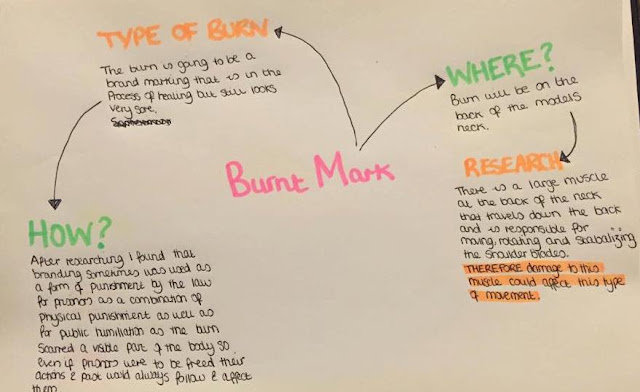1. Make a mould of the prosthetic out of the moulding clay using the sculpting tools on to a flat plastic surface
(you can use a hairdryer to apply heat to the clay to make it softer and easier to mould if necessary).
2. Spray the mould with fixing spray and petrolease (hold the sprays approx 20cm away from the mould) if possible out a window or in a well ventilated area to prevent a build up of fumes.
WEAR A MASK TO PREVENT YOURSELF FROM INHALING ANY FUMES.
3. Make a barrier around the mould that will be capable of holding the mixture to make your final mould ( you can do this by cutting the bottom off a plastic cup or if the piece is quite big you can also use moulding clay to create a wall around the prosthetic mould). Secure and fill in any possible gaps using a glue gun.
4. Whilst this is setting, cover your surface with cling film and begin measuring out equal amounts of plastil gels A and B using a scale and separate labelled lollipop sticks (label one A and the other B). Depending on how big your prosthetic piece is will depend on how much of each gel you will need (for example 30ml of plastil A and 30ml of plastil B for a small piece) to cover the entire sculpture.
WHEN MEASURING THE DIFFERENT PLASTIL GELS USE A SEPERATE SET OF GLOVES FOR HANDLING A AND B.
5. Carefully mix the two gels together, ensuring there are as few air bubbles as possible, then carefully pour the mixture into the clay mould evenly, leaving it to set for anywhere between 45 to 90 minutes.
6. Once this has set, slowly ease the new mould out of the clay and, using alcohol-isopropyl and a cotton pad, carefully wipe over and clean any residue or dirt (e.g. Pieces of moulding clay) until your new mould is completely clean.
7. Using the proportions 2:1 mix together alcohol and super-baldiez (e.g. If you use 30ml of alcohol then use just 15ml of the super-baldiez).
8. Spray the mould with petrolease (again if possible in a well ventilated area) and, once dry, take one of the wooden laminating brushes and apply 2-3 layers of the mixture over the prosthetic, leaving each layer to dry completely before applying the next (you can speed this process up by using a cool hairdryer)
9. Once this had all dried mix together equal amounts of plastil gels A and B and then in addition to this, mix in 60-75% (of A and B's total amount) of plastil deadener (e.g. 30ml of A, 30ml of B so 38-45ml of D).
REMEMBER TO USE SEPERATE, LABELLED STICKS TO MEASURE OUT THE GELS (A, B & D)
10. Being quick to ensure the mixture doesn't set, select the pigment you wish to colour the mixture and add a small drop to the mixed together gels. Adding the smallest drop and stirring will spread the pigment until eventually the whole mixture is an even colour.
11. Carefully pour this mixture into your mould evenly, making sure to cover all parts of the sculpture.
12. Then take a flat/straight edge (eg. A ruler) and lightly drag it across the top of the prosthetic, getting rid of any excess mixture and flattening the prosthetic so it's even when applying to the skin.
13. Leave the mixture to set for as long as possible, the minimum time being and hour.














